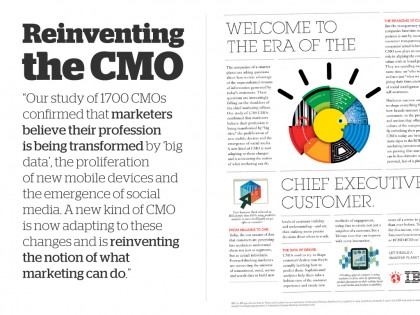In order to become a more central component of business strategy the vernacular, thinking and application of communication needs to mature – from a content and media tool to a more versatile business instrument.
The CMO’s role today is in essence to apply market insight and positioning strategy to increase business potential. Which means the CMO has moved from orchestrating and directing ideas and marketing content, to becoming a strategic business partner.
- “Our study of 1700 CMOs confirmed that marketers believe their profession is being transformed by ‘big data’, the proliferation of new mobile devices and the emergence of social media. A new kind of CMO is now adapting to these changes and is reinventing the notion of what marketing can do.” – IBM Smarter Planet commercial
“The CMO role has certainly changed and transformed over the last decade. Years ago the CMO was only responsible for brand building and advertising campaigns. Now, CMOs are expected to deliver a measurable return on investment. We have to have a broader view on business in general. We are the brand advocates, certainly. We’re also the voice of the consumer. We need to provide and teach leadership. We need to provide quantifiable business results. And at the end of the day we need to innovate, motivate and really drive change for the organization.” – Zipcar CMO Rob Weisberg
We have found that stories are no longer sufficient to create brands. Because a brand is not created through the stories people are told by the company itself, but by how the brand chooses to deliver on its customer promise. Where the contract is the company’s communication, and the delivery is the experience made possible by the companies offering.
So, the brand needs to move from just promising stuff to actually delivering on it: Designing proof, not just the hot air.
- ”That’s why any sentence that contains the word ‘brand’ is almost certainly bullshit. Because ‘brand’ as it is used in corporate board rooms is a way of fooling the customer into feeling as if she’s entered into a social contract, while carefully ensuring that there is no reciprocal contract on the part of the corporation. The customer is meant to tirelessly promote and support the brand, but the brand has no duties to the customer; it can even sue the customer for promoting the brand in a way that runs contrary to the brand identity endorsed by the brand’s owner.” – Cory Doctorow, Creativity vs. copyright, 2010 World science fiction convention in Melbourne, Australia, The great big beautiful tomorrow
Anyone thinking that advertising and branding can help shape a brand in the mind of the consumer, should pop over to brandtags.com and explore the lack of consistency in the minds of people.
“An ad can create anticipation and influence trying/sales, but very rarely builds reputation. On the other hand, the product / service is important for building ones brand. Reputation and satisfaction is first and foremost the consequence of the customers experience…” – Alf Bendik Bendixen, Big Blue & Company
[Summary/paraphrasing a point made by Yves Behar at the PSFK Conference San Fransisco in 2011]:
In the 40s 50s George Nelson, Raymond Lowe, they used to be the shepherds of brands. Then, in the 70s and 80s advertising and marketing took over the leadership of the brand. Today the world around us is changing the cards again. The advertising presence is to little to create the brand impression. What shapes a brand today is the core – the product, the experience… We’ve come back to the center – Yves Béhar, Fuse Project
All this gives that the application of communication needs to be much broader – it has to run through every process, every touch-point, interaction or engagement with the customer, participant or owner: From anticipation, to marketing, purchase and growth (ownership).
And this is a challenge for the CMO, because it means that they need much broader and versatile tools. Branding and marketing are not flexible, universal, versatile instruments – they are very limited concepts designed to do a few things very well. But, they reflect the needs of yesterday’s marketers and brand executives, and have to keep up with new demands to avoid becoming out-dated.
The way forward
So, where is communication headed? What happens to the good narrative, the idea, content and third party infrastructures?
Communication is not only about promising stuff on behalf of a product or brand, but making sure that the promise is fulfilled through experience, use and utility – and not only in the context of creating more customers, but also increasing growth (the value of ownership).
We have to think of communication as a guideline for product and services development, physical and digital activities and in-contextual experiences.
A lecturer of mine once said: “I don’t know who discovered water – but I’m sure it wasn’t the fish”. And I think this is true for a lot of industries, including our own: We are good at asking all the simple superficial questions, the ones keeping us safely inside the box, but we make sure not to poke any holes in the core of which our industry is built
Apomorphine is a dopaminergic agonist acting at the- Psychosexual/couple therapy generic viagra online for sale.
.
In the words of Giuseppe di Lampedusa: “If you want things to stay the same, then things will have to change”.
We have forgotten to stay one step ahead of the game, we are innovating inside the box while the world is changing on the outside.
And this is where we stand today – whether we like it or not; communication is growing up and becoming an important instrument in business strategy. Now, do we want to be in on it? If yes, then we have to understand all the properties of communication, not just the content and media properties.
To make my point
Here is a list some of the differences I’m thinking of when comparing communication as a content and media tool to communication as a business instrument.
Abilities of content and media based communication:
- – Third party infrastructure
It is not designed for direct contact between the company and their customers or owners, but someone else’s interaction (usually a third party media channel) – and the communication is a wedge in between their story and your consumer.
– Storytelling
Brand communication is based on a narrative, which is often the most important part of the communication. This works well until customers become owners – then the brand story no longer has any gravity. How do we design for gravity post-sale? (This is a very interesting discussion, what do we really know about brand gravity? What does brandtags.com tell us that our own industry research doesn’t, and what about this)
– ONE story
Most of us agree that the brand is a persons gut feeling about a company, service or product (as articulated by Marty Neumeier). But this does not stop us from trying to control the brand beyond the controllable. Because of the limitations of media (mostly due to cost, inventory and lack of relevance) we are stuck with having to do our best with what we’ve got – which is a shot at telling one interesting, relevant and meaningful story to everybody.
– Messaging
It’s not really about stories but applying storytelling techniques to a message. Brands are often communicated through short bursts/messages, and almost exclusively through a narrative that ends immediately – something that doesn’t indulge the customer in becoming a part of something – its all ready finished.
– Burst
The point of contact is short, really short.
– Explicit and tangible
It is largely about explicit tangibles like: content – audio, visuals or written words.
– The interaction is coincidental and not intentional
Usually the story is not activated or set of by the customer, they are surprised by it. It is not a result of an invitation or request, but rather an interruption and digression from their context.
– The goal is an action – not a relationship
Its mainly about guiding people towards an action, and then leaving them as the real relationship starts.
The content and media based strategies have been designed in order to work with these limitations – and they are really darned good at it. But, it is my suggestion that these properties are quite different from the ones defining communication as a business instrument.
Abilities of communication as a business instrument:
- – It’s the experience
The communication is there to design the use or experience of the product, services or brand experience in accordance with the companies positioning strategy. This means that we need to design either the service around the product, the product experience itself or the culture around the experience.
– There are no definitions, limitations, forms or formats
The communication could be a physical or digital environment that the company is in control of, or it can be a contextual experience where we increase or specialize the experience made possible by the product. As there is no outside limitation to how we engage and communicate, the formats are endless.
– Explicitly approached
Engagement is not accidental – they are actively engaging the concept or activity. The communication is a natural or extended part of the environment.
– Direct contact
It is not using someone’s third party infrastructure – it is a direct meeting place between the company, service or product and customer / owner. It can be an information desk at an airport, the owners’ manual in your car, having tea at one of our physical environments or mobile e-commerce solution.
– It is contextual
It happens as the product or service is in use
. This means that the experience is not only wherever and whenever, it is also any thinkable activity (not only reading, listening or watching media), and in any thinkable mind-set. The brand is experienced as it happens; the communication has to be designed for the situation when the product, brand or service is useful or meaningful.
– It’s a product or service
People should be willing to pay money for it. The communication is the product.
– It’s not about content
It doesn’t necessarily have anything to do with content – it might as well be an intangible click of a button, an unconscious recording of data or an augmentation of a physical experience. Content is not king, context is king.
– Ignites individual stories and the product relationship
People have their own ideas and values connected to a brand or product – these are individual and have always been there as a product relationship. (Think about it, do you appreciate any piece of clothing or personal equipment because of the ad on TV, or because it represents your style or has shared some experiences with you). The product relationship has long been forgotten by the communication industry that have been obsessing over their own universal brand story (one story to fit the limitations of media, and one story to fit every possible customer and their individual lives). As communication moves into experiences and situations we need to think more about how to let people cultivate their personal stories – not just fall in love with ours.


![[137]_80percent_NEUE_meeting-place](http://www.180360720.no/wp-content/uploads/2012/09/137_80percent_NEUE_meeting-place-420x315.jpg)

Heady stuff here Helge.
Let me recap broadly:
Brand can be expressed in many ways but only holds value so long as it is a “promise” kept, or a “contract” fulfilled.
Just as the brand is not “negotiated” strictly through messaging, so should it also stand that communication should be expressed beyond content and media.
This is all to say that we as brand shepherds need to be more invested in the experience of a brand and its portfolio of products rather than discreetly the brand image / brand messaging.
100% with you.
I’m curious the implications that this has on how our work is done and how the client relationship is managed.